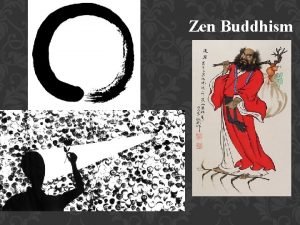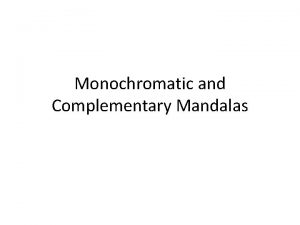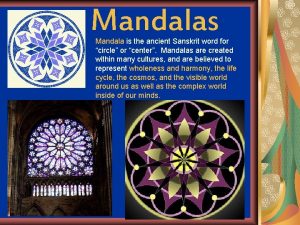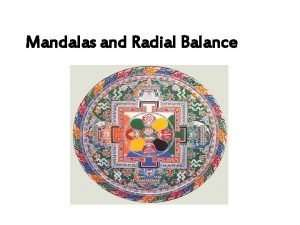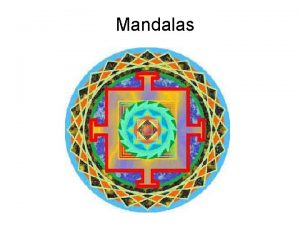Mandalas What is a mandala Mandala is Sanskrit











- Slides: 11

Mandalas

What is a mandala? • Mandala is Sanskrit for “whole world” or “healing circle. ” It is a representation of the universe and everything in it. • Circles suggest wholeness, unity, the womb, completion, and eternity. • Mandala generally speaking is a term for any geometric symbol that represents the cosmic energy metaphysically or symbolically.


Tibetan Buddhist Mandalas • In Tibet, the process of creating a mandala is as important as the finished product. It takes years of preparation and training to gain the skill and knowledge required to paint. Even when one is able to begin, meditation for three days must occur before brush can be put to canvas. The preparation of a mandala is an artistic endeavor, but at the same time it is an act of worship.

Sand Mandalas • Sand mandalas are another type developed by Tibetan Buddhist monks. The design is ritually prepared over a period of days, then blown away to represent the impermanence of life. The sand, which has been blessed throughout the process, is seen to benefit the land rivers it comes in contact with. Tibetans believe that a sand mandala contains the knowledge to achieve enlightenment in this lifetime.


Mandalas in the West • There is also a tradition of healing circles in the west. Powerful symbolism is seen in medicine wheels. Medicine wheels represent the universe, change, life, death, birth and learning. The great circle is the lodge of our bodies, our minds and our hearts. Although there are many parallels to the Tibetan mandala, Native Americans never used the word mandala to describe their sacred circles.


Carl Jung and Mandalas • Our culture is familiar with mandalas primarily because of the work of Carl Jung who became interested in them while studying Eastern religion. For Jung, mandalas are "vessels" into which we project our psyche. It is then returned to us as a way of restoration. He recognized that archetypes from many cultures were seen in this spontaneous expression of the unconscious. Circles are universally associated with meditation, healing, and prayer.


The Mandala’s purpose • Mandalas are seen as sacred places which, by their very presence in the world, remind a viewer of the immanence of sanctity in the universe and its potential in himself. In the context of the Buddhist path, the purpose of a mandala is to put an end to human suffering, to attain enlightenment , and to attain a correct view of reality. It is a means to discover divinity by the realization that it resides within one’s own self.








